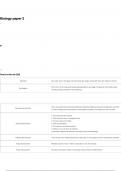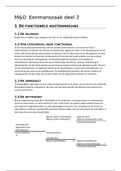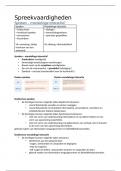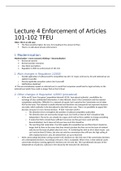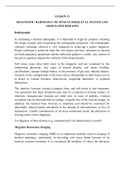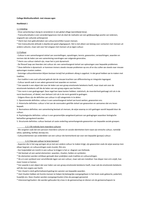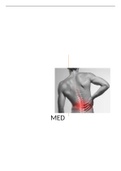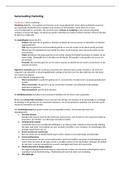UNIT 1 STUDY SKILLS .
The concept of learning is an active process that involves participation from the subjective being (learner) and not
merely the absorption of information.
Learner participation involves:
Questioning the information and, if necessary, change or re-interpret it
Gathering new ideas and info and making it your own
Relating said information to one’s own life and applying it in relevant situations in a meaningful way
Interacting/discussing with fellow students or the teacher
Sharing ideas, etc.
Van Schoor et al phased study process:
1. The exploration phase: entails the generalising of activities to find information about the topic. Getting
background information to become familiar with the work. Start to plan and manage time, contact fellow
students to sort out problems, discussing the topic, identify and clarify difficult concepts, get an overview of
the content, make summaries to study later
2. The fixation phase: Getting to grips with the real content and doing intensive reading. Full concentration on
detail. Consolidation of facts to fully understand material, summarize facts to capture most important
elements, memorise and rehearse to absorb the facts
3. The testing phase: To assess understanding of the material. Asking questions that cover the material
studied. May utilize ‘action words’ (compare, discuss, criticise, explain).
Study Environment
Elements that is helpful to study effectively:
Good relationships with those around you
Physical space: a particular place, be comfortable, proper lighting and ventilation, temperature control, no
interruptions, no distractions
Motivation
Two perspectives:
1. External motivation
Outside influence or consequences
Positive external motivation: if you pass you will get a bursary; if you pass with distinction you will get promoted
Negative external motivation: if you do not pass you will not be allowed to further register / get a bursary
2. Internal motivation
Intrinsic to the individual to achieve personal long or short term goals
Long-term goals: over a time period (months or years) with tools (signposts) to help reach them
Short-term goals: also referred to as objectives (minutes, hours, days)
Learning contract: practically writing down an agreement that help you stick to your program of study placed
somewhere that help remind you of your goals and commitments
Internal motivation should be more developed than external motivation. If you are self-motivated with the
right attitude and have the necessary confidence you can practically deal with many factors/challenges that
the external environment may pose
Healthy diet and lifestyle
Avoid unhealthy substances and refined foods, eat lots of fruit and veggies, eat small regularly, lots of water, get
enough sleep and exercise
Time Management
Page 1
,The ability to effectively prioritise one’s activities to have balance in work, study, rest and play.
Prioritise things or activities (wants and should do’s)
Time planning by utilising for instance Timetables (to help deal with procrastination, working only under
pressure, imbalance i.t.o. time allocation).
o Burns and Sinfield lists things to consider when planning timetables:
Morning, afternoon or night person? Fitting study around maximum performance times
Time with friends and family? Time for work and chores?
Can you keep your hobbies or interests going during this time?
Time for R&R
Study Groups
Humans are naturally group orientated. In most cases we identify with groups and are often part of groups. We
acquire and/or learn most things from our fellow humans – often this learning occurs unconsciously or indirectly
Belonging to a group helps us develop most of our thoughts, social skills and other behavioural patterns.
What makes a group work? The key feature of functional groups is the element of respect and integrity.
Important characteristics of a functional group:
Understand common objective
Observe basic house rules (speak one at a time, punctuality, prepare, etc)
Have roles defined (chairperson, scribe, time keeper, organiser, etc)
The group must be manageable – normally between 3-5 members
Each member to contribute to discussions
Must work co-operatively with preparedness
Constructive criticism is crucial
Benefits of a study group:
Can serve as a pool of motivation
Provide confidence to engage / participate in discussion
Different ideas and perspectives help better understanding
Comparing and discussion help to clarify issues and get better understanding
Disadvantages of a study group:
Some members do not contribute enough and become parasites
Some members dominate and have a detrimental effect on the group
Silent, passive participants that do not contribute
Different kinds of groups
a) The central figure
The person in the middle is responsible for the flow of communication
Model is suitable for simple tasks
C Disadvantage: central figure can be overloaded with information or C may block the flow of information
Success of this model relies on the leadership abilities of the person on charge
b) Decentralised Groups
Communication flows freely between members
Suitable for small groups
Fairly unstructured and can therefore lead to ‘’talk shows’’ without a leader
c) Free flow communication + chairperson
Page 2
, Communication flows freely between members
The person in the middle is responsible for the flow of communication
C Model used with biggest success
Note-making
Suggests writing down the important points and leave out the less important points.
It is therefore important to have sound reading skills in order to make notes.
One cannot make correct notes if one does not UNDERSTAND the material read.
Different reading techniques: speed-reading, skimming, scanning and study reading
For notes to be adequate and effective, they must contain main ideas, details and illustrations/ examples
Two types/styles:
1. Visual notes: schematic or diagrammatic (mind maps, spider grams, branching notes, tables, flow charts)
2. Narrative notes: textual and engage a lot of written work (linear notes, lists, time-line notes)
The choice of note making will depend on
i. Individual learning style
ii. Kind of subject matter (maths different from history subject)
iii. Time before examinations
iv. First time studying particular topic
Study methods
Mnemonics / memory strategies: strategy to recall certain words, figures, keywords, etc. Example:
o Acronyms: a combination of letters that is utilised to memorise a list of words/phrases (BODMAS)
o Classification: rearranging information in the order that will make it easier to remember by grouping
relevant or associated pieces of info together
Summaries: short/brief way of representing the contents of original text – only main important ideas
o Do not change the content and ideas of the original text
o Read whole text to understand full topic
o Find key points and identify keywords
o Write in simple language, be objective and factual
ACTION WORDS:
Analyse Divide into sections or elements and discuss in full.
Compare Id the similarities or differences btw facts or examine the differences btw ideas, facts, viewpoints
Contrast Point out the differences between certain objects or characteristics.
Criticise Point out the good and bad characteristics & give your own opinion after taking all the facts into account.
Define Give a short and concise definition (a summary of essential properties) of a subject or topic.
Describe Name the characteristics of an object or topic. You should do this in a logical, well-structured way.
Discuss a topic by examining its various aspects. Use a critical approach.
Evaluate Give your own opinion, using certain standards as a basis, about a topic.
Explain & clarify to ensure reader understanding. Use illustrations, descriptions or simple but logical explanations.
Assignments
Introduction Body Conclusion
The intro should be short, The main part of the assignment and Summarise the main argument and
outline the main argument and longest part of the essay in content of assignment
focus on the question paragraphs. Focus on the question
Develop argument, supply detail and Be brief
examples, support claims by stating
relevant facts
Page 3



